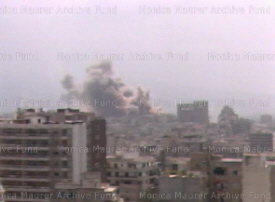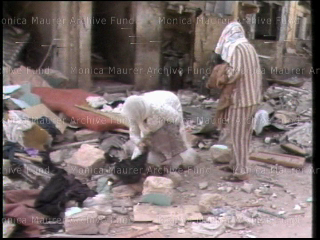A Palestinian film born out of Sabra & Shatila massacre, directed by the German filmmaker Monica Maurer.
 On September 17, 2012, Palestinians will commemorate the 30th anniversary of their still-continuous suffering of ‘Sabra & Shatila’, but in a different way.
On September 17, 2012, Palestinians will commemorate the 30th anniversary of their still-continuous suffering of ‘Sabra & Shatila’, but in a different way.
The day that will mark the 48-hour massacre committed by the Kataeb party’s militias (Lebanese Forces) against the Palestinian refugees’ camp south of Lebanese capital will be documented in a movie to keep it in memory forever. Attacking militias massacred 3500 people in an operation facilitated by the Israelis who were monitoring the onslaught from outside the camp.
It only took two days with the killing machine to complete the trial of eliminating the Palestinian organized presence in Lebanon, considering the claimed goal!
Monica Maurer, an Italian filmmaker and veteran journalist, came to Lebanon during the era of internal conflicts. She was there at the time of the massacre, recording events and shooting the dark brutality. Al-Manar Website met Maurer and had an exclusive interview with her.
 THE MISSION
THE MISSION
"Being a filmmaker, it is not easy to choose what to document. Apart from the passion in engagement for social and human justice, it is also the hot for Palestine, for all the oppressed people, and the fight for the rights of human dignity," that what incited Maurer to introduce such films showing how Palestinian refugees in Lebanon had lived the era between the 1970s and 1980s.
In her exclusive interview with Al-Manar Website, Maurer recites the scene after the dust of ‘Sabra & Shatila’ settled in 1982. "It became different from what it was three days before... There were children with their throats cut, rows of young men shot in the back after being lined up at an execution wall. There were slaughtered babies and their small bodies were tossed into rubbish heaps alongside discarded US army ration tins," she said
A Collective project for the future
Maurer – who lived the details of those moments - is now determined more than ever to unfold before the whole world and the international community what “Israel” they are supporting, what brutality they are applauding for and how muted the oppressed Palestinian people is.
“Young generations will pick up these values, and I hope they will succeed through their struggle and resistance. They will have successes in resisting the oppression that had done everything to stop them,” Maurer told Al-Manar Website.
| Lebanon, June-August 1982, Zionist invasion |
She clearly stated that in ‘Sabra & Shatila’ massacre, Zionist war on the camp’s residents had three aspects which were – and still – not so much mentioned by the media. The first was that 80% of the wounded and killed were civilians, as clearing territory from its population became a strategic goal for the killing machine.
The second, Maurer continues, was that popular resistance became a weapon for the people to defend their lives, where the Lebanese national movement and the Lebanese resistance made an outstanding act to defend their rights. While the third aspect was the use of internationally banned weapons aimed at eliminating human beings and their infrastructure.
“My objective is to safeguard the materials I had shot between 1977 and 1982, almost a hundred hours of films... I shot footage from the North to the South of Lebanon, Tyre, Nahr el-Bared, all Palestinian refugee camps in Beirut,” the veteran journalist added to Al-Manar Website.
The basic goal of Maurer’s upcoming film is to understand why the Palestinians’ revolution had stopped, why their infrastructure had been eliminated and why they were scattered all over the world.
The awaited film will show all kinds of Zionist weapons used during that era, starting from fragmentation shells and cluster bombs, to phosphorus shells and vacuum bombs, and various other internationally banned weapons of mass destruction.
| Lebanon, Beirut, June-August 1982, Zionist invasion |
PROJECT FOR FUTURE
“After 29 years of the massacre, I will try now to recall the moment of construction of an embryo, of an eventual future state in Palestine. That has the values that we all cherish; the democracy of participation of people, of control of leadership by the masses through mass organization, the principles of social justice, the respect for human dignity and education, the belief that you can grow, the dedication to construct something and give future to your children, in order to conserve this fragile equilibrium that we call “peace”,” the German-born film maker expressed.
Although Maurer tried to make a time line in her movie, however she realized this was not possible for her material were not enough. Thus she has to rely on another source to make the whole work more comprehensive.
The film will be divided into two parts, 80% of it will be the film shots, while the rest will be the elaboration and analysis of the material. “I felt that to mix these two kinds of archives was something that cinema didn’t work on,” she said.
| Lebanon, Beirut, August 1982, PLO withdrawal from Lebanon |
“I hope I can finish the project by September 2012, but fund-raising takes lot of time, where the only definite source so far is a grant from Audio-Vision Commission of the European Community,” Maurer concluded.
The Italian journalist has considerable expertise in making films that deal with working class struggles and their direspected and violated civil rights.
As a matter of fact, a large portion of the world’s population are in solidarity with the Palestinian people and their right of return to their homeland; however, solidarity is not only a word, but it is also about knowing, sharing, living with, and understanding the intimacy of each other's aspiration.
For those who didn’t have the chance to register their own shock on September 17, 1982, they will have it on the 30th anniversary of the massacre when they watch Maurer’s movie. Although what we found inside the Palestinian camp at ten o'clock on the morning of that gloomy day did not quite beggar description, but shooting events helps in commemorating the unforgivable sin.


